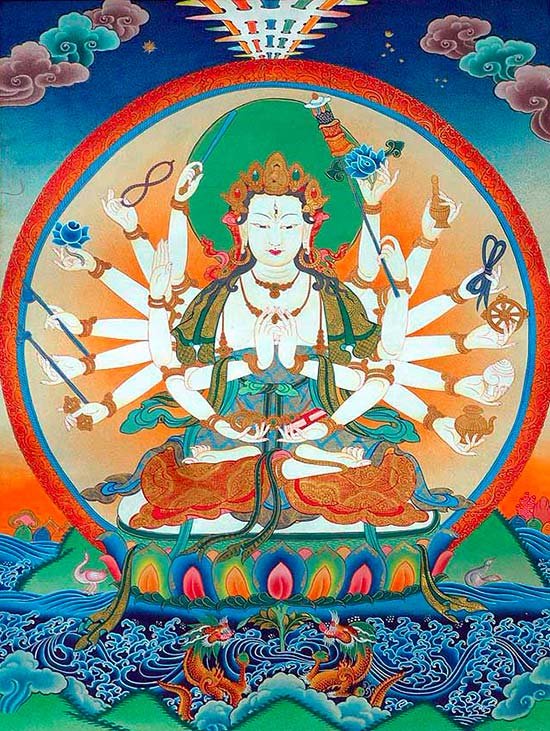Maha Prajnaparamita Sastra
by Gelongma Karma Migme Chödrön | 2001 | 941,039 words
This page describes “avadana of bakkula” as written by Nagarjuna in his Maha-prajnaparamita-sastra (lit. “the treatise on the great virtue of wisdom”) in the 2nd century. This book, written in five volumes, represents an encyclopedia on Buddhism as well as a commentary on the Pancavimsatisahasrika Prajnaparamita.
Avadāna of Bakkula
Thus, at the time of the Buddha Pi-p’o-che (Vipaśyin), the bhikṣu Po-kiu-lo (Bakkula) offered a a-li-lö (harītakī) fruit to the Community. For ninety-one kalpas he enjoyed happiness among gods and men. He was never sick. And today, having met the Buddha Śākyamuni, he went forth from [224a] home (pravrajita), destroyed his impurities (kṣīṇāsrava) and became arhat.
Since gifts as small [as those of Bakkula and Koṭīviṃśa (see his Avadāna)] produce such great fruits of retribution (vipākaphala), [the Community] is called ‘the best field of merit for the world’.
Notes to this Avadāna:
Anavataptagāthḥa, ed. Bechert, p. 144–145; tr. Hofinger, p. 227–229; Fo wou po ti tseu, T 199,p. 194b16–c11; Mūlasarv. Vin., Gilgit Man., III, part 1, p. 192–193, and T 1448, k. 17, p. 82c5–28:
Bandumatyāṃ rājadhyānyāṃ gāndhiko ‘hām … glānam abhijnanāmi tāvatkālikam apy aham.
Transl. –
In the capital of Bandhumatī, I was once the owner of a hardware shop and, at the time of Vipaśyin, I invited the community of monks. During the Rains, the Community was invited, but nobody asked anything of me, except for one monk who begged for a single myrobalan (harītaki). For ninety-one kalpas, I had not a single bad destiny. See how useful was the reward for this gift of medicine! I have enjoyed much happiness for having done this small meritorious action. Having given this single myrobalan, I rejoiced for a long time in the heavens. Then, by virtue of the residue of my action, I have obtained a human birth, and I do not remember having accepted, while I was śaikṣa, the least offering in the kingdom. My life-span [was one hundred and sixty years] during that existence and, in all that time, I do not remember having suffered any illness.
The Traité will return later to this bhikṣu: cf. k. 24, p. 238a5; k. 29, p. 271b18; k. 38, p. 341c3. This is a well-known monk called Bakkula, Vakula and Vākula in Sanskrit; Bakkula, Bākula and Vakkula in Pāli. The name means ‘Two families’ (dvakkula, dvikkula): actually, during his last lifetime, Bakkula had taken birth in a wealthy family in Kauśambī, but when his nurse was bathing him in the Yamunā, he was swallowed by a fish. The animal was sold to the wife of a merchant in Benares and when she opened the fish, she found the baby alive. She wanted to adopt him but the true parents of the child reclaimed him. The king cut through the dispute by declaring that the child henceforth belonged to the ‘two families’. At the age of eighty, Bakkula met the Buddha, entered into the monastic order and, after seven days, attained the state of arhat. He lived for eighty more years, clothed in rags and tatters, declining any offering of food and refusing to preach even a stanza of two pādas. The Buddha designated him as the foremost of those free of sickness and with few desires. After his death, a stūpa was built for him. Later, during his well-known pilgrimage of holy places, the emperor Aśoka, contrary to his well-known generosity, placed a single piece of gold on the funerary monument of the arhat, but the latter had had so little desire that the protector spirit of the stūpa refused the gold piece.
Sources on Bakkula:
The sources on Bakkula are very numerous, and here are the main ones:
Pāli sources. – Majjhima, III, p. 124–128; Anguttara, I, p. 25; Theragāthā, p. 29; Apadāna, p. 28–330; Commentaries on the Majjhima, IV, p. 190–197; on the Anguttara,I, p. 304–310; on the Theragāthā, p. 87; on the Apadāna, p. 481–483; Milinda, p. 215–217.
Sanskrit sources. – Mahākarmavibhaṅga, p. 75 (where Bakkula is given as the son of Dharmayaśas, king of Kaśmir); Divyāvadāna, p. 396.
Chinese sources. – Hien yu king, T 202, k. 5, p. 385b5–386a4; Vibhāṣā, T 1545, K. 181, p. 906c–907a; Fen pie kong tö louen, T 1507, k. 4, p. 45c17–46a28; Tchouwei mo kie king, T 1775, k. 3, p. 359b10; King liu yi siang, T 2121, k. 37, p. 201a1–9 (transl. Chavannes, Contes, III, p. 229–230).
